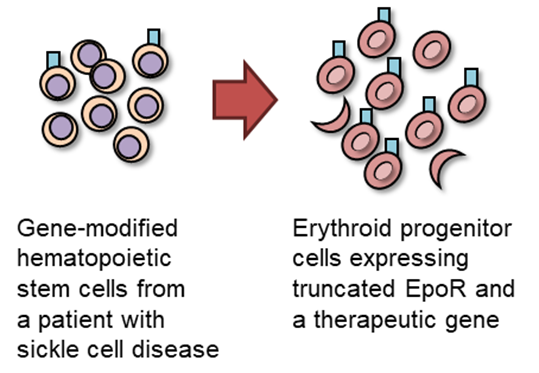Associate Professor Naoya Uchida of The Institute of Medical Science, The University of Tokyo in Japan and co-researchers at National Heart Lung and Blood Institutes (NHLBI) / National Institute of Diabetes and Digestive and Kidney Diseases (NIDDK), National Institutes of Health (NIH) and St. Jude Children's Research Hospital(SJCRH) in the U.S. demonstrate that co-expression of truncated human erythropoietin receptors (thEpoR) enhances erythropoiesis of gene-modified cells, resulting in improvement of the phenotypic effect of a therapeutic vector in erythroid cells in xenograft mouse and autologous non-human primate transplantation models. It was published in "Science Translational Medicine" on April 28, 2021.
Abstract
Hematopoietic stem cell gene therapy for hemoglobin disorders, including sickle cell disease, requires high-efficiency lentiviral gene transfer and robust therapeutic globin expression in erythroid cells. Erythropoietin is a key cytokine for erythroid proliferation and differentiation (erythropoiesis), and truncated human erythropoietin receptors (thEpoR) have been reported in familial polycythemia. We reasoned that co-expression of thEpoR could enhance the phenotypic effect of a therapeutic vector in erythroid cells in xenograft mouse and autologous non-human primate transplantation models. We generated thEpoR by deleting 40 amino acids from the C-terminus, allowing for erythropoietin-dependent enhanced erythropoiesis of gene-modified cells. We then designed lentiviral vectors encoding both thEpoR and B-cell lymphoma/leukemia 11A (BCL11A)-targeting microRNA-adapted short hairpin RNA (shmiR BCL11A) driven by an erythroid-specific promoter. thEpoR expression enhanced erythropoiesis among gene-modified cells in vitro. We then transplanted lentiviral vector gene-modified CD34+ cells with erythroid-specific expression of both thEpoR and shmiR BCL11A and compared these to cells modified with shmiR BCL11A alone. We found that thEpoR enhanced shmiR BCL11A-based fetal hemoglobin (HbF) induction in both xenograft mice and rhesus macaques, whereas HbF induction with shmiR BCL11A alone, though robust, was transient. thEpoR/shmiR BCL11A co-expression allowed for sustained HbF induction at 20-25% in rhesus macaques for 1 year. In summary, we developed erythroid-specific thEpoR/shmiR BCL11A-expressing vectors, enhancing HbF induction in xenograft mice and rhesus macaques. The sustained HbF induction achieved by addition of both thEpoR and shmiR BCL11A may represent a viable gene therapy strategy for hemoglobin disorders.
Enhanced erythropoiesis of gene-modified erythroid cells in gene therapy for sickle cell disease (SCD). Truncated human erythropoietin receptor (thEpoR) enhances erythropoietin-mediated erythropoiesis in gene-modified cells, enabling improved therapeutic effect (such as fetal hemoglobin induction) in hematopoietic stem cell (HSC) gene therapy in SCD.
About the research
1) Journal Article
Title:
Sustained fetal hemoglobin induction in vivo is achieved by BCL11A interference and co-expressed truncated erythropoietin receptor
Title:
Sustained fetal hemoglobin induction in vivo is achieved by BCL11A interference and co-expressed truncated erythropoietin receptor
Authors Information:
Naoya Uchida1,2*, Francesca Ferrara3, Claire M. Drysdale1, Morgan Yapundich1, Jackson Gamer1, Tina Nassehi1, Julia DiNicola1, Yoshitaka Shibata1, Matthew Wielgosz3, Yoon-Sang Kim3, Matthew Bauler4, Robert E. Throm4, Juan J. Haro-Mora1, Selami Demirci1, Aylin C. Bonifacino5, Allen E. Krouse5, N. Seth Linde5, Robert E. Donahue1, Byoung Ryu3,6, John F. Tisdale1
*Correspondence: NU
Affiliations:
1) Cellular and Molecular Therapeutics Branch, National Heart Lung and Blood Institutes (NHLBI) / National Institute of Diabetes and Digestive and Kidney Diseases (NIDDK), National Institutes of Health (NIH), Bethesda, Maryland (MD) 20892, USA
2) Division of Molecular and Medical Genetics, Center for Gene and Cell Therapy, The Institute of Medical Science, The University of Tokyo, Minato-ku, Tokyo 108-8639, Japan
3) Department of Hematology, St. Jude Children's Research Hospital (SJCRH), Memphis, Tennessee (TN) 38105, USA
4) Vector Development and Production Laboratory, SJCRH 38105, Memphis, TN, USA
5) Translational Stem Cell Biology Branch, NHLBI, NIH, Bethesda, MD 20892, USA
6) Umoja Biopharma, 1920 Terry Ave, Seattle, Washington (WA) 98101, USA
DOI: 10.1126/scitranslmed.abb0411
URL: https://stm.sciencemag.org/content/13/591/eabb0411
Funding
This work was supported by the Intramural Research Program of the National Heart, Lung, and Blood Institute (NHLBI) and the National Institute of Diabetes, Digestive, and Kidney Diseases (NIDDK) at the National Institutes of Health (NIH). This work was supported by the NHLBI grant P01632HL053749, the Assisi Foundation of Memphis grant #94-000 R18, and St. Jude Children’s Research Hospital Research Consortium “Novel Gene Therapies for Sickle Cell Disease".
Publication Journal
Contact
Research Contact
Associate Professor, UCHIDA Naoya
Division of Molecular and Medical Genetics, The Institute of Medical Science, The University of Tokyo (IMSUT)
https://www.ims.u-tokyo.ac.jp/imsut/jp/lab/cgct/section01.html
https://www.ims.u-tokyo.ac.jp/imsut/jp/lab/cgct/section01.html
Press Contact
Division for International Affairs office, The Institute of Medical Science, The University of Tokyo (IMSUT)
